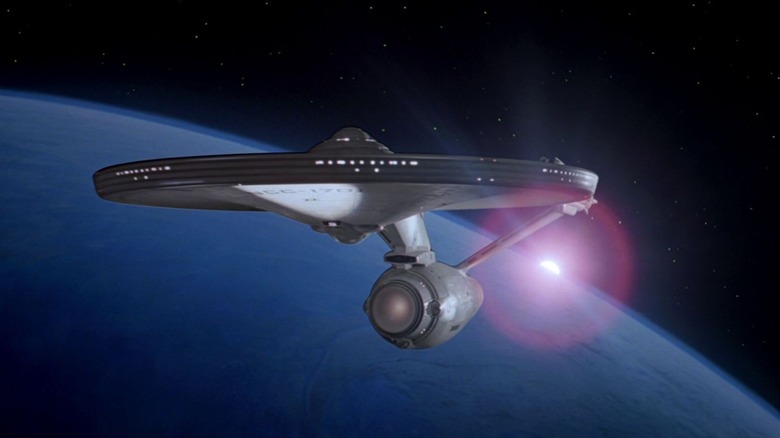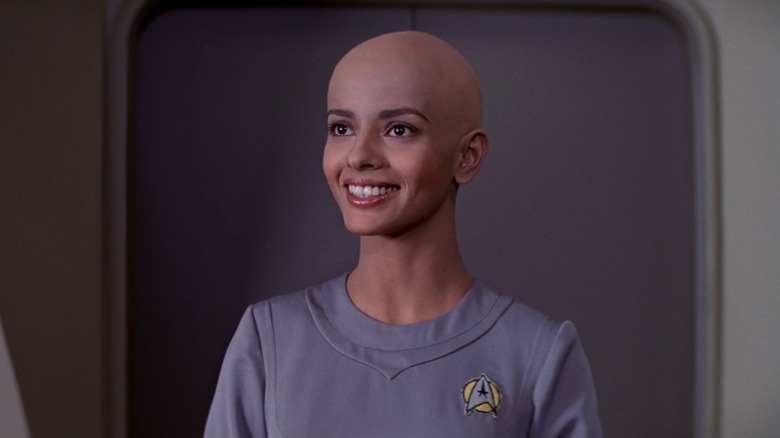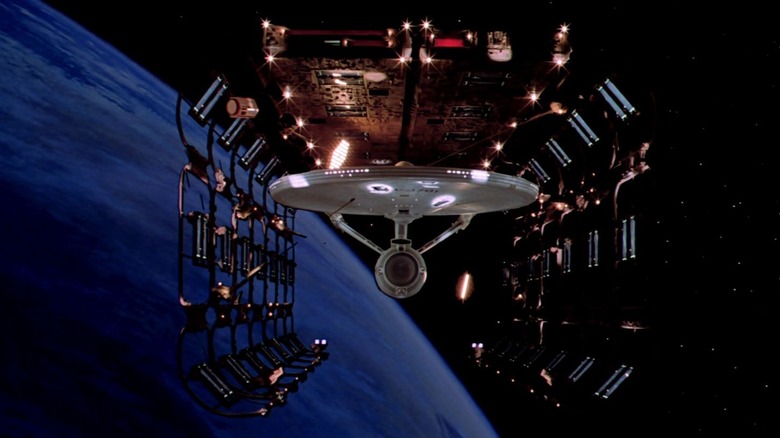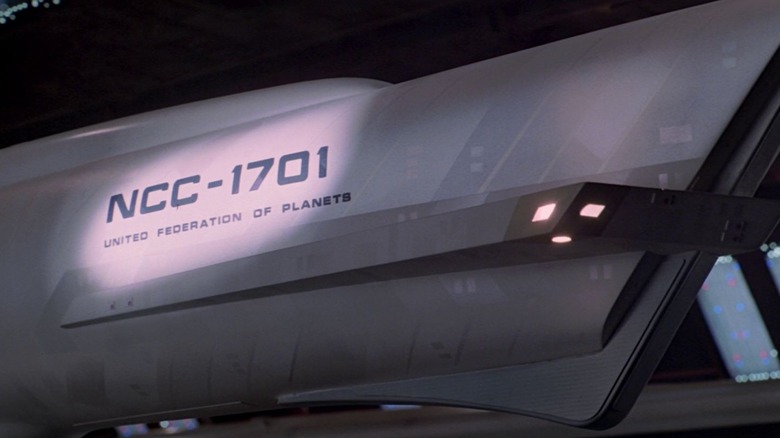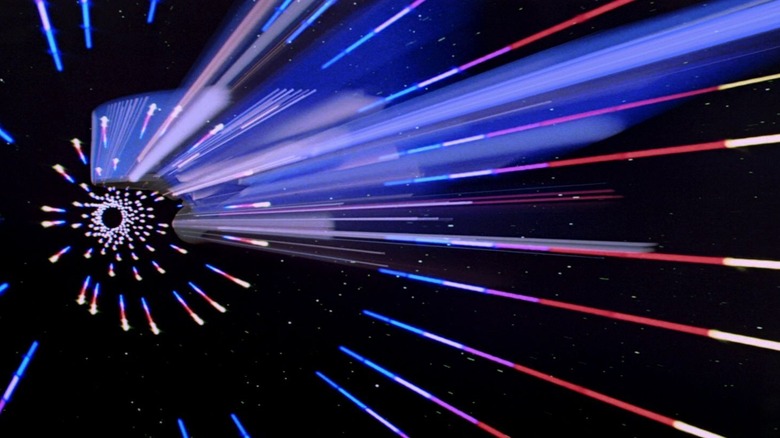Star Trek: Phase II - Everything We Know About Gene Roddenberry's Unmade Series
"Star Trek," as many may know, wasn't a huge hit during its initial 1966 to 1969 run. The series always struggled with low ratings, and only received a third season after a passionate letter-writing campaign kept it on the air. The third season, luckily, pushed "Star Trek" up to 76 episodes, which was just enough for syndication deals. "Star Trek" began airing in reruns in the early 1970s, and only then did the series find a wider — and widely obsessive — audience. Reruns allowed Trekkies to watch episodes multiple times, and develop their own theories about the Enterprise, about the show's technical devices, and about the characters' backstories.
The first official "Star Trek" convention was held in September 1972, and show creator Gene Roddenberry began showing up at subsequent cons to discuss his show and hear from fans about what they liked. I am convinced that it was during the convention circuit years that Roddenberry began to think of "Star Trek" differently. His series was always optimistic, but in discussion, he discovered he had created something almost utopian.
In 1973, Filmation revived "Star Trek" as an animated series, but it wasn't a huge hit (despite its excellent writing and the return of most of the original cast). But reruns continued to draw huge numbers. By 1977, "Star Trek" was running on 137 American stations. Roddenberry felt it was high time to reboot "Star Trek," but in a more perfect form.
In 1977, it so happened that Paramount — who owned "Star Trek" — wanted to launch its own TV network. The new network was to be called the Paramount Television Service, or PTS, and it would be only the fourth major TV network in the country (apart from NBC, CBS, and ABC). Roddenberry saw an opportunity, and announced that, with the launch of the new network, "Star Trek" would return. The new show: "Star Trek: Phase II."
Star Trek: Phase II
The idea behind "Star Trek: Phase II," sometimes also called merely "Star Trek II," was that the U.S.S. Enterprise would return, but retrofitted to look sleeker and more modern. The entire cast of the original series would return with the exception of Spock (Leonard Nimoy) who was angry at Roddenberry over various legal matters. Roddenberry did approach Nimoy about the possibility of returning, but only as a supporting character; Spock would be in only two out of every 11 episodes. Nimoy turned down the offer. William Shatner, Nichelle Nichols, Walter Koenig, DeForest Kelley, James Doohan, George Takei, and Majel Barrett, however, would all be back. Roddenberry also tried to include Grace Lee Whitney, but no one knew where she was at the time. As it turns out, she was wrestling with addiction.
Shatner had negotiated such a large paycheck for "Phase II" that he began to figure that Kirk would be killed at the end of "Phase II'"s first season just to save the studio some money. He knew that Paramount already had a contingency plan to replace him just in case. For "Phase II," it seems that things were rocky from the start.
The main cast was to be expanded by three new characters. There was to be a bald, libidinous Deltan named Ilia, and actress Persis Khambatta was cast in the role. Without Spock, the showrunners invented a new Vulcan character named Xon, to be played by actor David Gautreaux. There was also to be a human executive officer named Willard Decker, although that part was never cast.
One might note that Ilia and Decker were the names of characters from 1979's "Star Trek: The Motion Picture." Keep that in mind, as "Star Trek: Phase II" would eventually evolve and mutate and eventually become "Motion Picture." Before that, however, the plans were large.
Watch at 8, Eastern
"Phase II" was eventually to become the flagship series of the PTS, and was to air at 8 p.m. on Saturday nights, followed by a movie-of-the-week, beginning on February 1978. The pilot episode was to be a two-hour mega-event, and Roddenberry had a story in mind: Based on a failed follow-up for his TV series "Genesis II," Roddenberry adapted his script for "Robot's Return," a tale about a massive, destructive alien spacecraft returning to Earth, seeking its maker. Roddenberry thought that would be a great idea for the "Phase II" pilot, and hopped to get a script together quickly.
One might also note that "Robot's Return" was the story for "The Motion Picture."
In order to keep things efficient, Roddenberry commissioned multiple scripts for "Phase II" episodes, wanting to have several in the queue should production need to start immediately after the pilot. A lot of writers and designers were brought on board, many of them new to "Star Trek." "Phase II" kept the original show's costume designer, but hired a whole new staff to redesign the Enterprise. The basic shape of the ship was to remain the same, but most of the details were to be changed, including the shape of the engines. This was the same Enterprise, but it was also improved for a 1970s generation.
Meanwhile, however, there was trouble in the writers room. Roddenberry thought it would be easy for a writing staff to pen scenes for classic characters, but that wasn't the case. Many of the writers struggled with the way the classic characters were to interact with Ilia, Decker, and Xon; the dynamic never quite emerged. Roddenberry wasn't concerned, however, as he felt the dynamic would evolve as the series progressed, and characters' roles could grow or shrink depending on how much Trekkies liked them.
Why was it canceled?
It's unclear as to whether or not Roddenberry had yet installed his infamous non-conflict rule, dictating that no "Star Trek" story could emerge from interpersonal conflicts. That rule, it seems, was going to be leaned on heavily a decade later when Roddenberry made "Star Trek: The Next Generation."
For a while, there was so much chaos among the writers that "Phase II" had to hire a story editor, a man named Jon Povill. Sadly, he wasn't able to do much wrangling. It seems that, despite all the commissions, "Phase II" had trouble finding experienced writers who could work quickly. It wasn't until the last minute that writer Alan Dean Foster was able to turn in a draft for the "Phase II" pilot. His final title for the pilot was "In Thy Image."
Everything was slowly coming together. One can even find a few of the Enterprise designs for "Phase II" online, as well as photos of Khambatta and Gautreaux in their uniforms. The production of "Phase II" wasn't very clean, but a series was forming. The budget was to be notoriously high, with the pilot estimated to cost about $3.2 million, a record at the time. Roddenberry talked a big game, saying that the new series would be aggressively political, covering stories about nationalism and terrorism. He also wanted an uptick in female characters, hoping to show them in positions of authority, something he wasn't allowed to do in the 1960s.
"Phase II" was halted, however, thanks to a single meeting with Michael Eisner, then the head of Paramount. Eisner stated that he liked the story for "In Thy Image," but had always envisioned it as a feature film. He also pointed out that advertising revenue wasn't coming together for the PTS, and that a new network wouldn't be possible. Without the PTS, "Phase II" stepped onto shaky ground. Eisner said that he instead wanted to parlay the production into a "Star Trek" feature film.
The evolution into Star Trek: The Motion Picture
At this point, "Phase II" had already cost $500,000 to make, and the studio had to appear committed, lest they start to lose credibility. Also, Eisner couldn't announce a new "Star Trek" movie at this point as Paramount had made a few idle announcements throughout the 1970s that they would be making a "Star Trek" movie. Another announcement would have been meaningless, and proved how weak the project was. Eisner put the kibosh on "Phase II," but had to allow production to continue for months thereafter, hoping to save face.
Press releases said that the PTS was being pushed back, and that "Star Trek: Phase II" was continuing production, but by 1978, there was already an earnest move behind the scenes to turn the series into a feature film. By January 1979, the whole project was a movie. "In Thy Image" was adapted into a big-screen script, Nimoy was talked into coming back, and the $44 million "Star Trek: The Motion Picture" would be released in December. Ilia and Decker remained characters for the movie, with Stephen Collins being cast as the latter. Xon, sadly, was nixed.
13 episodes of "Phase II" had already been written, and Roddenberry kept them on his desk for years. Two of them — "The Child," and "Devil's Due" — would be reused for episodes of "Star Trek: The Next Generation." The sets that were being built for "Phase II" became the foundation for "The Motion Picture," and remained on the same soundstage for decades. Even "Star Trek: Voyager" was built on the same foundation in 1995.
In 1997, a full report of "Phase II" was published as "Star Trek Phase II: The Lost Series," written by Judith and Garfield Reeves-Stevens. Every small detail and personnel change that occurred throughout the unmade show's production can be found there.
Would it have been good? It's hard to say. We certainly would not have a "Star Trek" film franchise without "Phase II," nor would Roddenberry have spitefully pushed "Next Generation" into production without the disappointing box office of "Motion Picture." It seems that everything turned out the way it as supposed to.
